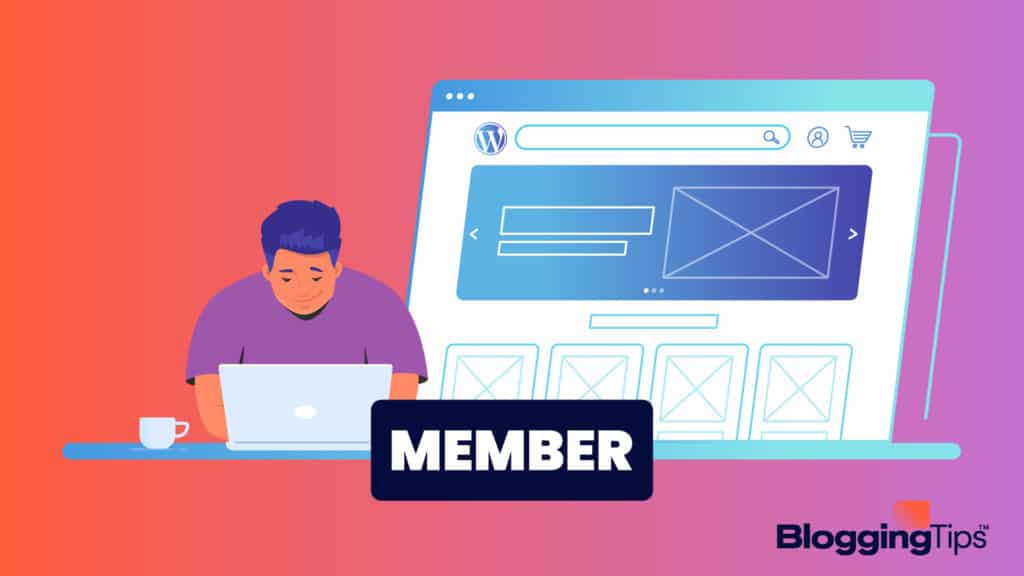Do you want to create a recurring revenue stream for your business?
If so, then you should consider creating a membership website.
A membership website is a site that offers exclusive content or services to paying members.
In this article, we will discuss the benefits of using a membership website, what to offer inside the membership, and the costs involved with starting one.
We will also provide a step-by-step guide that details how to create a membership website.
Frequently Asked Questions
Let’s begin by answering commonly asked questions about membership websites.
Getting these questions answered upfront will help lay the groundwork as you learn how to create a membership website.

What is a membership website?
A membership website is a site that offers exclusive content or services to paying members.
For example, if you have a blog about knitting, then your membership site might offer exclusive patterns and video tutorials to paying members.
Or, if you have a blog about personal finance, your membership site might offer exclusive budgeting tools and courses to paying members.
How do membership websites work?
Most membership websites use a subscription-based model, where members pay a monthly or annual fee to access the exclusive content.
Some membership sites offer a one-time payment for lifetime access.
Others use a tiered pricing model, where members can pay different prices for different levels of content.
What should I offer on a membership website?
The content you offer inside your membership site will depend on the niche of your main site.
Some ideas for exclusive content include the following:
-Video tutorials
-eBooks
-Downloadable PDFs
-Printables
-Exclusive blog posts
-Courses
-Webinars
-Q&A sessions
The key is to offer content that your target audience will find valuable and that they can’t get anywhere else.
Do membership websites make money?
Yes, a membership website can be an effective way to generate recurring revenue for your business.
The amount of money you make will depend on the number of members you have and the price of your membership.
If you have a large number of members, then you can make a full-time income from your membership website.
How much does a membership website cost to start?
The costs of starting a membership website will vary depending on the software you use, your hosting fees, and any other tools or services you need.
In general, you can expect to spend anywhere from $50-$500 to get started.
If you’re using premium software or hiring someone to help you set up your site, your costs will be on the higher end.
What You’ll Need To Make a Membership Website
There are four main considerations to think through before getting started with building your membership website.
Vision for the Website
Some questions you can ask yourself to help narrow down the purpose of your site include the following:
- Who is my target audience?
- What problem am I solving for them?
- How often will I release new content?
Strategic Plan To Execute On
Your strategic plan should answer the following questions.
- How will I generate traffic to my site?
- How will I monetize my site?
- Who will create the content for my site?
Research of Your Target Audience
Take time to research and understand your target audience.
The better you understand your target audience, the easier it will be to create a site that appeals to them.
No-code Website Builder Platform/Program
The easiest way to build a membership website is to use a no-code membership platform or program.
The no-code option requires little technical knowledge.
Step by Step Instructions To Create a Membership Website
Let’s review the steps from start to finish when building a membership site.
1. Spec Out Your Goal for Your Membership Website
Before taking action, create a detailed plan that helps you decide on the type of content to provide and how to monetize that information.

What Will the Site Do?
A membership website provides content that sits gated behind a paywall.
Will you create an online course where people sign up to get access to lessons and materials?
Or, will you use a collection of video tutorials, e-books, or audio files?
Think about what you can offer that other websites cannot.
That is your niche.
Your membership website should focus on a specific topic, hobby, or interest.
For example, let’s say you want to create a website about plant-based recipes.
Your niche is that your recipes are gluten-free, vegan, and use only ingredients found at the farmer’s market.
People who pay for your membership site’s content should feel like they’re getting valuable content they can’t find elsewhere for free.
Who Is Your Website’s Audience?
Now that you know what content you’ll provide, it’s time to think about who will want to consume it.
People willing and able to pay for the type of content you offer make up your target market.
Some questions you should ask yourself include the following:
- Who are they?
- What are their interests?
- What are their pain points?
- What type of content would they find valuable?
How Will the Membership Website Be Monetized?
Your next step is determing how you will make money from your membership.
There are a few ways to monetize a membership website:
- Offer a monthly subscription
- Charge per piece of content
- Sell ads for revenue
- Sell products or services
- Have an annual membership
You can also offer a combination of these options.
Determine the method by the type of content you plan to offer and your target market.
For example, if you’re planning on offering video content, you could use paid memberships as your primary monetization method.
You could also sell products or services related to the videos as an upsell.
Or, if you’re planning on offering an online course, you could use a per-course fee or annual subscription model.
You could also add a private blog to your membership website and include ads as another way to monetize the site.
The monetization method you choose needs to fit with the type of content you offer and your target market.
The important thing is that you decide on a monetization strategy before you start building your website.
That way, you can structure your content and site accordingly.
2. Choose a No-code Membership Website Builder
There are two main types of platforms available: code-based and no-code.
No-code platforms give you the ability to build a membership website without coding knowledge.
They’re also more affordable than code-based solutions and much easier to use.
Some of the best no-code membership platforms include the following:
When choosing a platform, ensure it offers the features and functionality you need to build the type of membership website you want.
It should also integrate with any other software or tools you plan to use.
For example, if you want to offer video content, make sure the platform can host videos or at least make it easy to add Vimeo or YouTube scripts to its pages.
Or, if you want to offer an online course, ensure the platform can easily host your course material.
Consider the following factors:
- Ease of use
- Flexibility
- Pricing
- Customer support
- Features
- Integrations
3. Design and Build Your Membership Website

The first design issue to consider is the look and feel of your site.
Your website’s design should match the tone of your brand and the type of content you offer.
For example, if you offer high-quality video content, your website should have a sleek and professional design.
If you offer more lighthearted or casual content, your website can be more playful in its design.
Your website’s design should also be easy to navigate.
Make sure users can find the content they’re looking for without any difficulty.
You don’t want users to get frustrated and leave your site because they can’t find what they need.
Consider the importance of a membership website’s homepage.
It’s where you need to make a good first impression.
Your homepage needs to convert visitors into members.
It should have a strong headline, explain the membership’s benefits, and include a clear call-to-action (CTA) that tells visitors what to do next.
4. Build the Back End of the Membership Portal
It’s time to start building the back end.
In this step, you’ll add and organize all your content, set up payment plans and access levels, and manage members.
Most membership platforms have an easy-to-use interface that lets you drag and drop content into place.
When adding content to your membership website, organize it using an easy-to-navigate structure.
You don’t want your members to feel overwhelmed or lost when they’re trying to find something.
A good way to organize your content is by using categories and subcategories.
For instance, if you offer video content, you could have a “Videos” category with subcategories for each type of video content you offer.
You could also use tags to organize your content.
For example, you might tag all the videos that belong to a series or that you created for beginners.
After adding the content, it’s time to set up payment plans and access levels.
When setting up payment plans, consider the value you’re offering.
You should also consider the type of content you’re providing and how often you plan on releasing new content.
If you offer a mix of video and written content, for instance, and you release new content every week, you can charge more than a membership that only offers written content that’s released monthly.
Think about how to give members a reason to upgrade.
If you offer a basic membership, you can create a premium membership that includes exclusive content, early access to new content, or a private forum where members can interact.
5. Publish the Membership Website Live
Most membership platforms will provide you with a couple of ways to go “live” with the site.
You can either use a subdomain provided by the platform or connect your domain name to the membership website.
If you want to use your domain name, you’ll need to change your DNS settings and point them to the membership platform.
After publishing the site, double-check that everything works as it should.
You should ensure all the links work, the content loads properly, and members can sign up and log in without any issues.
6. Promote and Market Your Membership Website

The final step is to start promoting your new membership website.
The best way to do this is by creating content that’s specifically designed to attract your target audience.
If you have an existing blog, you can write blog posts related to the content inside your membership website.
You can also create social media posts and run ads that target people interested in the type of content you offer.
It’s a good idea to reach out to influencers and ask them to promote your membership website.
For example, if you offer a cooking membership, you could reach out to popular food bloggers and ask them to mention your site in their next blog post.
You can also run contests and giveaways where people can win free access to your membership website.
Consider using partnerships as another way to get exposure to your membership website.
Go on podcasts, run webinars to partner email lists, and perform “lives” on your partners’ YouTube, Instagram, and Facebook platforms.
On these partnership opportunities, invite the audiences to opt-in to a relevant lead magnet offer.
On the backend, you can promote your membership website to these new email subscribers on your list.
Wrapping Up
Creating a membership website can be a lucrative way to generate revenue.
It allows you to offer exclusive content and services that your customers will appreciate.
Remember to set goals, choose the right software, and promote the membership.
Did you enjoy our tutorial for getting things set up?
Please leave a comment or ask a question in the comments below.
We’d also appreciate it if you shared this article with others who also want to know how to create a membership website.







